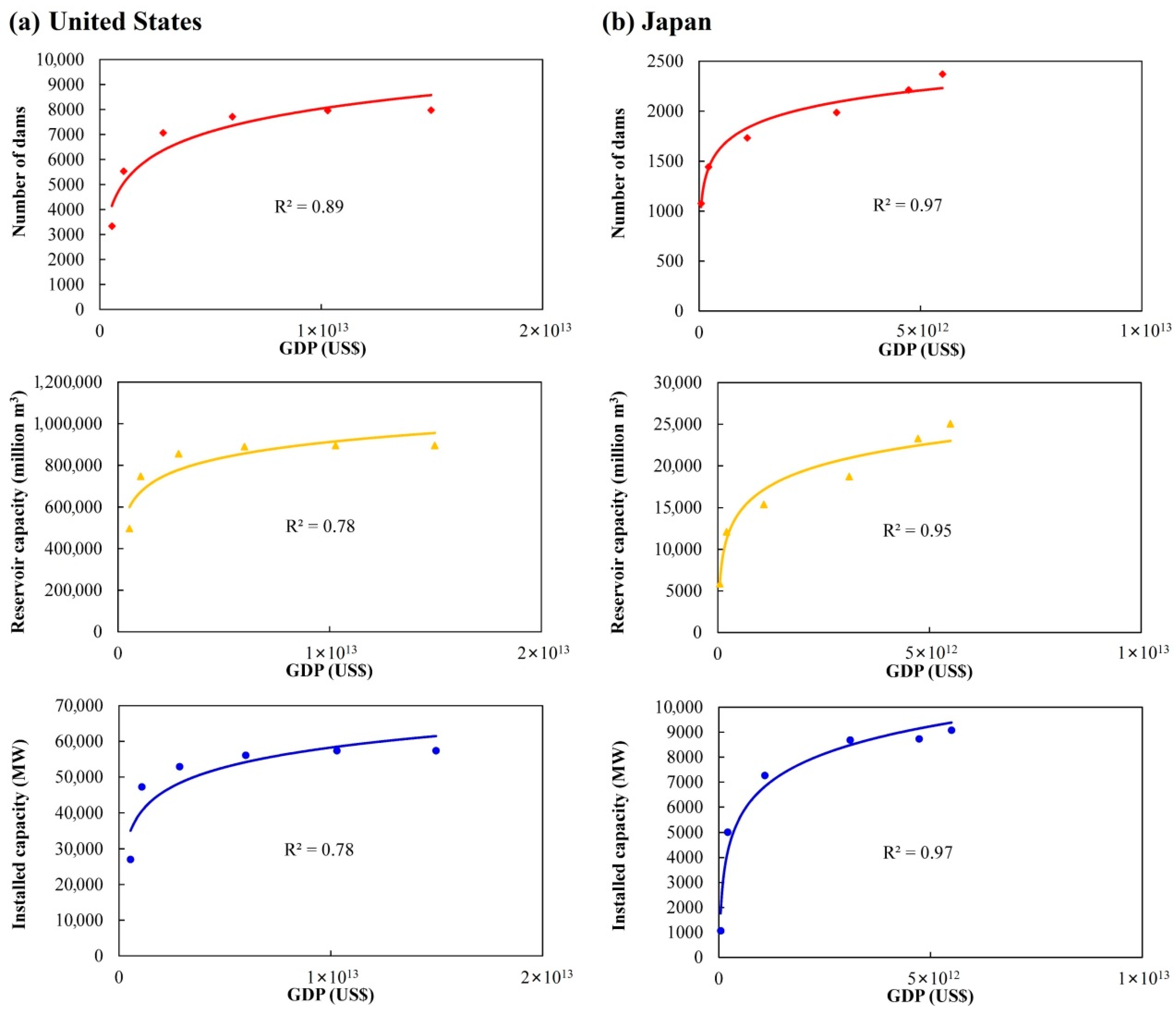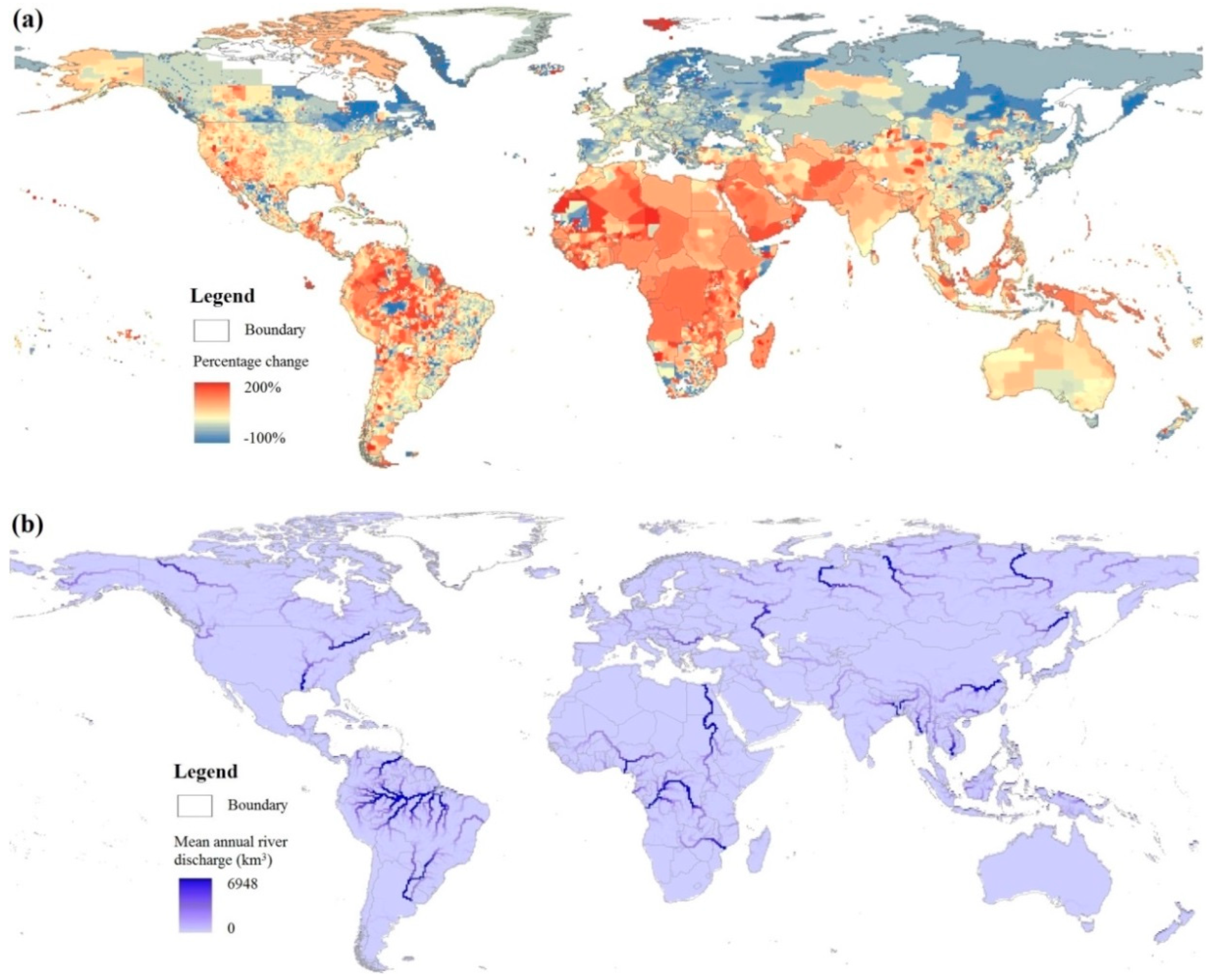The Role of Large Dams in Promoting Economic Development under the Pressure of Population Growth
Abstract
:1. Introduction
2. Materials and Methods
2.1. Groups of Countries
2.2. Research Data
2.3. Regression Method and Assessment Criteria
2.4. Projection of Future Population Growth
3. Results and Discussion
3.1. Overview of Global Dams and GDP
3.2. Relationship of Large Dams with GDP
3.3. Future Population Growth and Economic Development
3.4. Discussion
4. Conclusions
Author Contributions
Funding
Acknowledgments
Conflicts of Interest
References
- United Nations (UN). World Population Prospects, the 2015 Revision. 2015. Available online: https://esa.un.org/unpd/wpp/Download/Standard/Population/ (accessed on 1 March 2016).
- Rosegrant, M.W.; Cai, X.; Cline, S.A. World Water and Food to 2025: Dealing with Scarcity; The International Food Policy Research Institute: Washington, DC, USA, 2002. [Google Scholar]
- United States Department of Agriculture (USDA). World Grain Consumption and Stocks, 1960–2009. 2009. Available online: http://www.fas.usda.gov/psdonline (accessed on 1 June 2015).
- REN21. Renewables 2011 Global Status Report; REN21: Paris, France, 2011. [Google Scholar]
- International Energy Agency (IEA). Key World Energy Statistics 2012; IEA: Paris, France, 2012. [Google Scholar]
- World Resource Simulation Center (WRSC). Global Water Consumption 1900–2025. 2012. Available online: http://www.wrsc.org/attach_image/global-water-consumption-1900-2025 (accessed on 1 June 2015).
- Chen, J.; Shi, H.; Sivakumar, B.; Peart, M.R. Population, Water, Food, Energy and Dams. Renew. Sustain. Energy Rev. 2016, 56, 18–28. [Google Scholar] [CrossRef]
- United Nations Educational, Scientific and Cultural Organization (UNESCO). World Water Resources: A New Appraisal and Assessment for the 21st Century; UNESCO: Paris, France, 1998. [Google Scholar]
- United Nations Development Programme (UNDP). Human Development Report 2010—The Real Wealth of Nations: Pathways to Human Development; UNDP: New York, NY, USA, 2010. [Google Scholar]
- International Water Management Institute (IWMI). International Water Management Institute Analysis Done for Comprehensive Assessment of Water Management in Agriculture Using the Watersim Model, Chapter 2. 2007. Available online: http://www.grida.no/graphicslib/detail/areas-of-physical-and-economic-water-scarcity_1570 (accessed on 1 May 2015).
- IWMI. Water for Food, Water for Life: A Comprehensive Assessment of Water Management in Agriculture; Earthscan: London, UK; IWMI: Colombo, Sri Lanka, 2007. [Google Scholar]
- Wu, Y.; Chen, J. An Operation-Based Scheme for a Multiyear and Multipurpose Reservoir to Enhance Macroscale Hydrologic Models. J. Hydrometeorol. 2012, 13, 270–283. [Google Scholar] [CrossRef]
- Wu, Y.; Chen, J. Estimating irrigation water demand using an improved method and optimizing reservoir operation for water supply and hydropower generation: A case study of the Xinfengjiang reservoir in southern China. Agric. Water Manag. 2013, 116, 110–121. [Google Scholar] [CrossRef]
- Spänhoff, B. Current status and future prospects of hydropower in Saxony (Germany) compared to trends in Germany, the European Union and the World. Renew. Sustain. Energy Rev. 2014, 30, 518–525. [Google Scholar] [CrossRef]
- Shi, H.; Wang, G. Impacts of climate change and hydraulic structures on runoff and sediment discharge in the middle Yellow River. Hydrol. Process. 2015, 29, 3236–3246. [Google Scholar] [CrossRef] [Green Version]
- Shi, H.; Li, T.; Wang, K.; Zhang, A.; Wang, G.; Fu, X. Physically based simulation of the streamflow decrease caused by sediment-trapping dams in the middle Yellow River. Hydrol. Process. 2016, 30, 783–794. [Google Scholar] [CrossRef]
- Shi, H.; Chen, J.; Wang, K.; Niu, J. A new method and a new index for identifying socioeconomic drought events under climate change: A case study of the East River basin in China. Sci. Total Environ. 2018, 616–617, 363–375. [Google Scholar] [CrossRef]
- World Water Assessment Programme (WWAP). The United Nations World Water Development Report 4: Managing Water under Uncertainty and Risk; WWAP: Perugia, Italy, 2012. [Google Scholar]
- Poff, N.L.; Hart, D.D. How dams vary and why it matters for the emerging science of dam removal. BioScience 2002, 52, 659–738. [Google Scholar] [CrossRef]
- World Bank. Directions in Hydropower. 2009. Available online: http://documents.worldbank.org/curated/en/2009/03/12331 040/directions-hydropower (accessed on 1 June 2015).
- WWAP. The United Nations World Water Development Report 2016: Water and Jobs; WWAP: Perugia, Italy, 2016. [Google Scholar]
- World Commission on Dams (WCD). Dams and Development: A New Framework for Decision-Making; WCD: Frankfurt, Germany, 2000. [Google Scholar]
- Nilsson, C.; Reidy, C.A.; Dynesius, M.; Revenga, C. Fragmentation and flow regulation of the world’s large river systems. Science 2005, 308, 405–408. [Google Scholar] [CrossRef] [PubMed]
- United Nations Population Fund (UNFPA). Population Dynamics in the Least Developed Countries: Challenges and Opportunities for Development and Poverty Reduction; UNFPA: New York, NY, USA, 2011. [Google Scholar]
- BBVA Research. BBVA EAGLEs: Emerging and Growth-Leading Economies; BBVA Research: Bilbao, Spain, 2012. [Google Scholar]
- SouthAfrica.info. New Era as South Africa Joins BRICS; Brand South Africa: Johannesburg, South Africa, 2011. [Google Scholar]
- International Commission on Large Dams (ICOLD). The World Register of Dams. 2013. Available online: http://www.icold-cigb.net (accessed on 1 May 2015).
- Lehner, B.; Liermann, C.R.; Revenga, C.; Vorosmarty, C.; Fekete, B.; Crouzet, P.; Döll, P.; Endejan, M.; Frenken, K.; Magome, J.; et al. Global Reservoir and Dam Database, Version 1 (GRanDv1): Reservoirs, Revision 01. 2011. Available online: http://sedac.ciesin.columbia.edu/ data/set/grand-v1-reservoirs-rev01 (accessed on 1 May 2015).
- World Bank. World Development Indicators. 2016. Available online: http://data.worldbank.org/data-catalog/world-development-indicators (accessed on 1 July 2017).
- Center for International Earth Science Information Network (CIESIN), Centro Internacional de Agricultura Tropical (CIAT). Gridded Population of the World, Version 3 (GPWv3); NASA Socioeconomic Data and Applications Center (SEDAC): Palisades, NY, USA, 2005. [CrossRef]
- Caspary, G. Assessing, mitigating and monitoring environmental risks of large dams in developing countries. Impact Assess. Proj. Apprais. 2009, 27, 19–32. [Google Scholar] [CrossRef]
- Grant, G. Dam removal: Panacea or Pandora for rivers? Hydrol. Process. 2001, 15, 1531–1532. [Google Scholar] [CrossRef]
- Lejon, A.G.; Malm Renöfält, B.; Nilsson, C. Conflicts associated with dam removal in Sweden. Ecol. Soc. 2009, 14, 4. [Google Scholar] [CrossRef]
- Fox, C.A.; Magilligan, F.J.; Sneddon, C.S. “You kill the dam, you are killing a part of me”: Dam removal and the environmental politics of river restoration. Geoforum 2016, 70, 93–104. [Google Scholar] [CrossRef]
- Noda, K.; Hamada, J.; Kimura, M.; Oki, K. Debates over dam removal in Japan. Water Environ. J. 2018, 32, 446–452. [Google Scholar] [CrossRef]
- Ding, L.; Chen, L.; Ding, C.; Tao, J. Global Trends in Dam Removal and Related Research: A Systematic Review Based on Associated Datasets and Bibliometric Analysis. Chin. Geogr. Sci. 2019, 29, 1–12. [Google Scholar] [CrossRef]
- Beck, M.W.; Claassen, A.H.; Hundt, P.J. Environmental and livelihood impacts of dams: Common lessons across development gradients that challenge sustainability. Int. J. River Basin Manag. 2012, 10, 73–92. [Google Scholar] [CrossRef]
- Miao, C.; Borthwick, A.; Liu, H.; Liu, J. China’s Policy on Dams at the Crossroads: Removal or Further Construction? Water 2015, 7, 2349–2357. [Google Scholar] [CrossRef]
- Feng, G. The key to bring the Yellow River under control is to speed up construction of check-dams in the Sandy and Grit Areas. Sci. Technol. Rev. 2000, 145, 53–57. (In Chinese) [Google Scholar]
- Li, J.; Li, T.; Liu, S.; Shi, H. An efficient method for mapping high-resolution global river discharge based on the algorithms of drainage network extraction. Water 2018, 10, 533. [Google Scholar] [CrossRef]
- The International Journal on Hydropower and Dams. World Atlas & Industry Guide. 2010. Available online: https://www.hydropower-dams.com/product/world-atlas-industry-guide/ (accessed on 1 July 2014).
- Kummu, M.; Ward, P.J.; de Moel, H.; Varis, O. Is physical water scarcity a new phenomenon? Global assessment of water shortage over the last two millennia. Environ. Res. Lett. 2010, 5, 034006. [Google Scholar] [CrossRef] [Green Version]
- Wada, Y.; Gleeson, T.; Esnault, L. Wedge approach to water stress. Nat. Geosci. 2014, 7, 615–617. [Google Scholar] [CrossRef]
- Organization for Economic Co-operation and Development (OECD). Mitigating Droughts and Floods in Agriculture: Policy Lessons and Approaches, OECD Studies on Water; OECD: Paris, France, 2016. [Google Scholar]
- Sivakumar, B. Water crisis: From conflict to cooperation—An overview. Hydrol. Sci. J. 2011, 56, 531–552. [Google Scholar] [CrossRef]
- Huang, Y.; Lin, W.; Li, S.; Ning, Y. Social Impacts of Dam-Induced Displacement and Resettlement: A Comparative Case Study in China. Sustainability 2018, 10, 4018. [Google Scholar] [CrossRef]
- Tilt, B.; Gerkey, D. Dams and population displacement on China’s Upper Mekong River: Implications for social capital and social-ecological resilience. Glob. Environ. Chang. Hum. Policy Dimens. 2016, 36, 153–162. [Google Scholar] [CrossRef]
- Kumar, D.; Katoch, S.S. Sustainability indicators for run of the river (RoR) hydropower projects in hydro rich regions of India. Renew. Sustain. Energy Rev. 2014, 35, 101–108. [Google Scholar] [CrossRef]
- Biemans, H.; Haddeland, I.; Kabat, P.; Ludwig, F.; Hutjes, R.W.A.; Heinke, J.; von Bloh, W.; Gerten, D. Impact of reservoirs on river discharge and irrigation water supply during the 20th century. Water Resour. Res. 2011, 47, W03509. [Google Scholar] [CrossRef]
- Urban, F.; Siciliano, G.; Nordensvard, J. China’s dam-builders: Their role in transboundary river management in South-East Asia. Int. J. Water Resour. Dev. 2018, 34, 747–770. [Google Scholar] [CrossRef]
- Independent Evaluation Group (IEG). World Bank Lending for Large Dams: A Preliminary Review of Impacts; IEG: Washington, DC, USA, 1996. [Google Scholar]
- UNDP. Human Development Report 2006—Beyond Scarcity: Power, Poverty and the Global Water Crisis; UNDP: New York, NY, USA, 2006. [Google Scholar]
- Zhuang, W. Eco-environmental impact of inter-basin water transfer projects: A review. Environ. Sci. Pollut. Res. 2016, 23, 12867–12879. [Google Scholar] [CrossRef] [PubMed]
- Sun, J.; Dang, Z.; Zheng, S. Development of payment standards for ecosystem services in the largest interbasin water transfer projects in the world. Agric. Water Manag. 2017, 182, 158–164. [Google Scholar] [CrossRef]
- Kefayati, M. Empirical evaluation of river basin sustainability affected by inter-basin water transfer using composite indicators. Water Environ. J. 2018, 32, 104–111. [Google Scholar] [CrossRef]





| Group | Country |
|---|---|
| Developed Countries: 44 in total | Australia, Austria, Andorra, Bahrain, Barbados, Belgium, Brunei Darussalam, Canada, Czech Republic, Cyprus, Denmark, Estonia, Finland, France, Germany, Greece, Hong Kong (China, SAR), Hungary, Iceland, Ireland, Israel, Italy, Japan, Liechtenstein, Luxembourg, Malta, Monaco, Netherlands, New Zealand, Norway, Poland, Portugal, Qatar, Republic of Korea, San Marino, Singapore, Slovakia, Slovenia, Spain, Sweden, Switzerland, United Arab Emirates, United Kingdom, United States |
| Least Developed Countries (LDCs): 49 in total | Afghanistan, Angola, Bangladesh, Benin, Bhutan, Burkina Faso, Burundi, Cambodia, Central African Republic, Chad, Comoros, Democratic Republic of the Congo, Djibouti, Equatorial Guinea, Eritrea, Ethiopia, Gambia, Guinea, Guinea-Bissau, Haiti, Kiribati, Lao People’s Democratic Republic, Lesotho, Liberia, Madagascar, Malawi, Maldives, Mali, Mauritania, Mozambique, Myanmar, Nepal, Niger, Rwanda, Samoa, São Tomé and Príncipe, Senegal, Sierra Leone, Solomon Islands, Somalia, Sudan, Timor-Leste, Togo, Tuvalu, Uganda, United Republic of Tanzania, Vanuatu, Yemen, Zambia |
| Developing countries: 150 in total | All the other countries, including BRICS |
| Year | 1960 | 1970 | 1980 | 1990 | 2000 | 2010 |
|---|---|---|---|---|---|---|
| Number of large dams | 9056 | 14,968 | 22,361 | 27,559 | 30,773 | 32,473 |
| GDP | 1.16 × 1012 | 2.77 × 1012 | 1.07 × 1013 | 2.25 × 1013 | 3.28 × 1013 | 6.49 × 1013 |
| Country | Brazil | India | China | South Africa |
|---|---|---|---|---|
| GDP vs. Number of large dams | 0.99 | 0.92 | 0.82 | 0.93 |
| GDP vs. Reservoir capacity | 0.95 | 0.91 | 0.97 | 0.91 |
| GDP vs. Installed capacity | 0.97 | 0.94 | 0.92 | 0.84 |
© 2019 by the authors. Licensee MDPI, Basel, Switzerland. This article is an open access article distributed under the terms and conditions of the Creative Commons Attribution (CC BY) license (http://creativecommons.org/licenses/by/4.0/).
Share and Cite
Shi, H.; Chen, J.; Liu, S.; Sivakumar, B. The Role of Large Dams in Promoting Economic Development under the Pressure of Population Growth. Sustainability 2019, 11, 2965. https://doi.org/10.3390/su11102965
Shi H, Chen J, Liu S, Sivakumar B. The Role of Large Dams in Promoting Economic Development under the Pressure of Population Growth. Sustainability. 2019; 11(10):2965. https://doi.org/10.3390/su11102965
Chicago/Turabian StyleShi, Haiyun, Ji Chen, Suning Liu, and Bellie Sivakumar. 2019. "The Role of Large Dams in Promoting Economic Development under the Pressure of Population Growth" Sustainability 11, no. 10: 2965. https://doi.org/10.3390/su11102965
APA StyleShi, H., Chen, J., Liu, S., & Sivakumar, B. (2019). The Role of Large Dams in Promoting Economic Development under the Pressure of Population Growth. Sustainability, 11(10), 2965. https://doi.org/10.3390/su11102965







